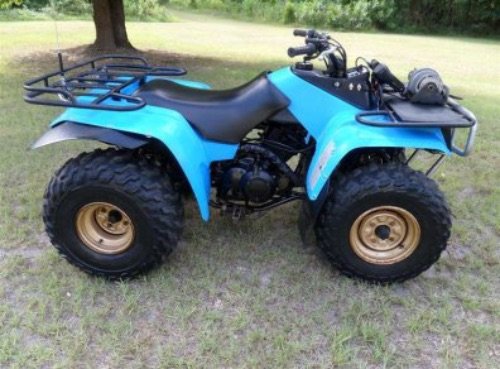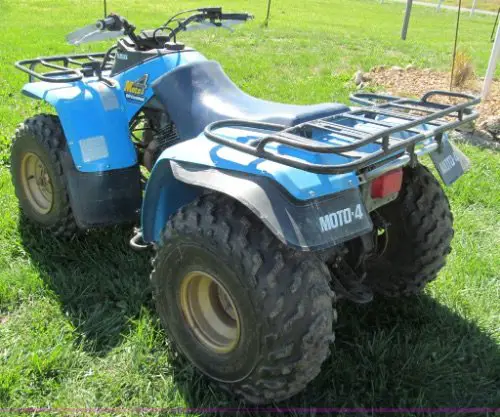
Up until 1985, any ATV launched on the ATV market would have had three wheels on it. Yamaha decided that this wasn’t enough, so they launched the Yamaha Moto 4. This was the very first ATV to ever offer 4-wheels.
The Moto 4 completely changed the world of ATVs. It wasn’t long before every other ATV manufacturer decided that 4-wheel ATVs were the way to go.
In the almost 10-year lifespan of the Moto 4, Yamaha produced several different models, each improving on the last. While the Moto 4 has long since been discontinued, the spirit of this model lives on in all ATVs the company produces.
Contents
Specification and Features
While there are several model years for the Moto 4, most people look at the Moto 4 under one of the various model numbers it has been released under. Each of these models will have slightly different specs. These are the base specs for each of the models, but Yamaha enthusiasts should bear in mind that these specs can change ever so slightly depending on the model year.

It is worth noting that the first three iterations of the Moto 4 were very similar outside of the engine capacity. It wasn’t until the Moto 4 350 that people started to see larger changes to the design of the vehicle.
Every vehicle produced under the Moto 4 banner was a driveshaft model.
The Moto 4 is unique compared to many of the ATVs that release today. This is because most of the products in the Moto 4 range offered a choice between 2WD and 4WD. As a result, those planning on purchasing one of these ATVs will have to pay attention to what model that they are purchasing. Of course, a 4WD model should be easy to drive off-road.
In addition to this, the Moto 4 models from the 250 onward offer both automatic and manual transmission options, with the former being easier to find on the open market.
All of the products include an electric ignition and Dunlop tires. Even today, the majority of people that run a Moto 4 will use Dunlop tires. The vehicle has been built for them.
Yamaha Moto 4 200 Specs
Despite being the world’s first 4-wheel ATV, the Moto 4 200 certainly wasn’t lacking in features.
Offering a 200cc, air-cooled engine, the Moto 4 200 is able to traverse even the toughest of terrain with ease.
This vehicle offers a 5-speed automatic transmission, including a reverse gear. The maximum power output of the Yamaha Moto 4 200 is 11.5kW.
It weighs in at 183kg.
Yamaha Moto 4 225 Specs
The Yamaha Moto 4 225 is the same as the Moto 4 200 in most features. The major exception is the 225cc motor.
A big change did happen in some of the later models of the Moto 4 225, though. The original 220 did not have suspension on it. However, halfway through the lifespan of the Moto 4 225, the company started to offer suspension on their ATVs. This means that buyers will need to pay special attention to the model that they are purchasing.
One common replacement part on the 225 models is the carburettor. Replacement parts aren’t too expensive, a KIPA carburettor with gasket costs under $50.
Yamaha Moto 4 250 Specs
The Moto 4 250 included an upgraded motor, as well as a couple of changes in the design of the body. However, it was not a huge increase on the later models of the 220.
Yamaha Moto 4 350 Specs
The Yamaha Moto 4 350 is the model that Yamaha stuck with for almost 8-years before it was used as a base for a new line of ATVs from the company.
The Yamaha Moto 4 350 with its 350CC motor is the most powerful vehicle in the Moto 4 range and the one that most people will encounter on the market. This is because the other models were only produced for a year or so.
Model Years Available
The 1985 Yamaha Moto 4 was the first four-wheeled ATV available in the Moto 4 range. This product built upon the 3-wheeled Yamaha Tri-Wheel that the company had been offering for the previous half-decade.

The 1986 Yamaha Moto 4 improved upon the design of the 1985 model, but the overall vehicle is very similar.
It is with the 1987 Yamaha Moto 4 that the company took the plunge into creating something different. They produced the Yamaha Moto 4 350 which lasted all the way up until 1995.
In 1995, the Moto 4 name was ‘retired’, but the legacy of the Moto 4 continued to live on in various other products from the company including the Big Bear and the Raptor. If the vehicle has a YFM designation in the model number, there it is likely it was based upon the Moto 4. The last of these spin-off products were produced in 2013.
Pros of the Yamaha Moto 4
Despite the Yamaha Moto 4 range being a product line that has long since been discontinued, there are plenty of people using the ATV. This means that it is solidly built, and the age will often ensure a person gets a good deal on it.
The ATV performs great despite the age too. Despite it being one of the earliest ATVs on the market, Yamaha certainly managed to pack a ton of features into the Moto 4 range, and each model year they improved upon the last. There is a reason why the Moto 4 formed the base for the design of many of their future products.
Despite the age, the Yamaha Moto 4 is still an immensely popular product. This means that if a person does stumble across issues with their ATV, there are plenty of people out there willing to help them out. Any company that repairs ATVs will certainly have seen the Moto 4 come through their doors over the years.
Cons of the Yamaha Moto 4
This is an older model of ATV. Modern ATVs have drastically improved upon the design of the Yamaha Moto 4. So, while it is a vehicle that performs well, it is lacking many of the quality of life features that can be found on more modern ATVs from Yamaha.
There are still spare parts available for this vehicle. However, since it has been 26-years since the last Moto 4 was produced, the number of spares on the market is dwindling. There will eventually be a point where it will become almost impossible to repair this vehicle without having to have spare parts engineered from scratch.
With 2WD and 4WD options available, with the latter being most common, purchasers will have to do their research to ensure that they are purchasing an ATV that is suitable for their needs.
Conclusion
The Yamaha Moto 4 will certainly go down in the history of ATVs. It is the one that started the 4-wheel ATV craze. It has been 25-years since the model was discontinued, but many of them are still going strong off-road today. iItis no wonder that so many people are looking to buy them still.
